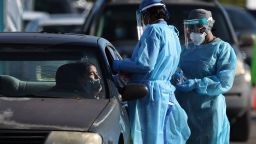There have been an estimated 140 million Covid-19 infections in the US, the US Centers for Disease Control and Prevention estimates, even though only 74.3 million cases have been reported as of January 31.
The data comes from the CDC’s nationwide antibody seroprevalence survey, in which it’s working with state, local, academic and commercial partners to test blood samples for antibodies to the coronavirus triggered by infection, not by vaccination. By measuring Covid-19 seroprevalence, the study provides an estimate of the percentage of the population that was previously infected.
The blood samples are submitted to commercial labs for unrelated reasons, such as routine medical checkups, and identifying information is removed. Every two weeks, researchers collected data from these samples, which encompass all 50 states, Washington, DC, and Puerto Rico.
The agency estimates that about 43% of the country has had the virus as of late January, including almost 60% of children up to age 18, nearly half of people 18 to 49, 37% of those 50 to 64 and 23% of those 65 and older.
Wisconsin has the highest seroprevalence, with an estimated 56.1% of its population infected by the coronavirus at some point. Vermont has the lowest, at 17.8%. Estimates for Nevada, Utah, Arizona and North Dakota could not be provided due to low numbers of samples from these states.
“I think this reflects more exposure than immunity,” said Dr. Peter Hotez, dean of the National School of Tropical Medicine at Baylor College of Medicine. “I think what people should take from that is about half the country’s been infected with Covid-19, which is pretty extraordinary itself.”
The statistics recorded from this seroprevalence survey are a big jump from the 74.3 million total number of Covid-19 cases reported, which is measured using antigen testing or PCR testing of viral RNA. This difference may lie with a large portion of asymptomatic or mild cases of Covid-19 that are not identified through testing, leading to an underestimate of total Covid-19 infections. Many people have also recently been relying on at-home Covid-19 antigen tests, which generally are not reflected in the CDC databases.
Keri Althoff, an associate professor of epidemiology at the Johns Hopkins Bloomberg School of Public Health, told CNN that although the CDC data can accurately say who does or doesn’t have antibodies, “what it doesn’t tell us is: Are those antibodies high enough to actually protect against infection if the virus would come that person’s way again?”
The presence of antibodies does not imply protection from reinfection, and the survey does not measure how much antibody is present.
Studies have shown that the level of protective antibodies created from an infection can last longer than those from vaccination, but the CDC does not recommend using antibody testing to assess for immunity to Covid-19.
“The Covid infections themselves have created a lot of immunity. How durable, how strong, what the duration of that immunity is, remains to be determined,” said Dr. William Schaffner, a professor in the Division of Infectious Diseases at Vanderbilt University Medical Center.
At the end of November, according to the CDC estimates, there had been 102.9 million infections. This would mean more than 30 million infections came in December and January, as the Omicron wave swept the country.
According to Hotez, the Omicron variant mainly affects the upper respiratory system, “and there’s literature there that says the upper respiratory coronaviruses do not induce much in the way in terms of durable protection,” he told CNN.
Though it’s not possible to draw conclusions about overall immunity against reinfection from these studies, they do provide scientists and policy makers with a broad overview of how the population was affected by the pandemic.
“What these data are designed to give us a sense of is: What’s the magnitude of the issue? It’s a little like looking at some mountains across a big plain. You can see where the mountains rise, where they peak and where they fall. You don’t have to count every tree to get the big picture,” Schaffner said.
For example, as hospitalization and death rates trend down, this data can explain why.
“These data … give us some expectation, assuming that this protection lasts for a while, that we can continue to plan about moving from the pandemic phase to the endemic phase,” Schaffner said. “These data undoubtedly played a substantial role in the CDCs decision to revise its masking recommendations.”
However, there are limitations to the data. Althoff said that because it sources blood work done for non-Covid purposes, it’s important to consider who is being left out of the study.
Get CNN Health's weekly newsletter
Sign up here to get The Results Are In with Dr. Sanjay Gupta every Tuesday from the CNN Health team.
“Who’s having blood work done? People who have access to health care. And what do we know about this virus? … It disproportionately impacted communities of lower socioeconomic statuses, communities that also tend to have a lower access to health care,” she said, noting that the seroprevalence measure is probably an underestimate.
Nevertheless, the data offers a snapshot of one source of immunity for the US population.
“As we’re peeling back these mandates … it’s important to know we’ve got a pretty good cushion of population immunity going on right now. And we’re going to have to watch it closely, because that will wane,” Althoff said.





















